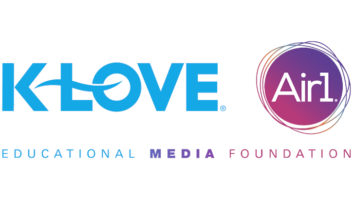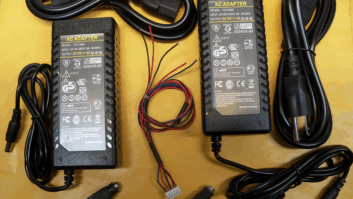
Sometime during my career, I suspect that the engineer running the universe ordained me as the Oracle of Very Small Mixers.
From the LPB Blue 5A more than a decade ago throughproducts made by Arrakis, Harris, Mackie and perhaps more — if a mixer was tiny and had a valid use in radio broadcasting and production, it would eventually make its way to me.
Being an enthusiast of low-power and community radio, as well as finding the least expensive way to pull something off, I suppose it’s a title I can live with.
Which is how the Audioarts Engineering Air-1USB radio console got my attention. A small, solidly-built radio mixer with a straightforward layout and USB audio I/O, the Air-1USB combines features desirable in a larger mixer with the engineering legacy behind Audioarts and Wheatstone — in an extremely compact chassis.
Product Capsule
Audioarts Engineering Air-1USB
Broadcast Mixer
THUMBS UP
• Digital logic and durable buttons for channel on/off control
• Two separate audio busses
• Versatile switching matrix for input levels and cueing
THUMBS DOWN
• Ganged headphone/monitor select
• Rear-mount headphone jack
Price $1,885
For information, contact Jay Tyler at Audioarts Engineering in North Carolina at (252) 638-7000 or visit audioartsengineering.com.
If you manage a multistation digital radio facility, a houseful of Air-1USB mixers probably isn’t on your radar. But as I have said before in prior articles, if you are running an LPFM, a Web radio station, school station or a Part 15er, or a small commercial operation needing to replace a struggling console that you hung on to for far too long, read on.
Wow, That’s Small…
The Air-1USB shares a common trait with all the other mixers I have reviewed: It’s danged small, at just a little over 15 inches wide and under a foot deep.
But the Audioarts engineers didn’t take anything away from the design when they shrank it in the wash. The Air-1USB has two mic inputs, six line inputs and one USB Type B socket, speaker muting, selectable levels on inputs — really all of the things you see in competitors’ consoles; except this mixer has two audio busses, a PGM 1 and PGM 2 line (“Audition” to you old-timers), just like the big boys have.
That means a separate bus for switching mics and telephones to record off-air callers. Console splits are possible for combo operation; feed the transmitter off PGM 1 and a separate streaming channel on PGM 2. The second bus can also feed an outboard effects box for oldies-style mic reverb, for instance.
The AIR 1USB design also addressed an issue common to many of the other boards I’ve reviewed: mechanical switches that did not feel as if they would last more than a few months. The Air-1USBinstead uses fairly robust momentary contact pushbuttons for channel on/channel off functions.

The switches don’t carry audio on their own, but instead rock a 74LS74 flip-flop chip that gates a 4053 analog multiplexer IC, where the actual audio is handled. Again, like the big consoles do.
Audio connections are to the back panel via balanced 1/4-inch TRS jacks (see sidebar), and levels are switchable via board-mounted slide switches, accessible on the underside of the mixer. Note you cannot bolt down the mixer to the tabletop, lest you need quick access to the switches.
Some pretty good thought went into configuring those switches, too; offering cue-to-monitor (to put cue audio up on the studio speakers), split mon and split head for deciding where to place that cue signal, a mono sum switch for either bus if you are feeding a monaural AM station, and a USB-out switch cluster to pick whether PGM 1 or 2 is feeding the USB port.
Bring your own cue speaker. There is not a lot of room inside the Air-1USBto mount a capable speaker, but there is a jack to plug one in. Also bring your own relay for the tally lights. The Air-1USBgives you a closure socket, but nothing that can handle 120 VAC. Wire that up as an external circuit.
And even though the TRS jacks are clearly marked, label your wires and cables going in and out of the Air-1USB. There is one socket marked “Spare” that, for all I know, goes nowhere (a future feature perhaps?). Plugging into that will make nothing happen.
Digital angle
The USB port provides bidirectional transfer of digital audio, which is handy when interfacing the Air-1USBwith an audio computer without tying up an analog input. The console is seen as a “sound card” under Windows and Linux (I did not check it under the Mac OS, but the manual tells you how).

One consideration would be to run the station automation system in and out of this port, but I would suggest this feature is better served for recording or production.
Many automation systems are multichannel affairs with the main playlist on one fader, the cart wall on another, the cue+audition line on yet another, and so on. The Air-1USBputs the USB input on fader channel 8 only.
If you are running a simple uncomplicated playout system with only one output channel, then plug into the USB port. Otherwise, put each output from the computer on a dedicated fader for the flexibility you need when going live.
By the way, you may notice USB audio moving through at a lower level than you are used to, especially if your operators tend to ignore levels. According to the tech folks at Audioarts, the USB port is hardwired to accept 0 VU as – 20 dBFS (SMPTE standard RP.0155).
For folks who believe in “using the entire meter,” this may seem irksome. I consider it an opportunity to zero all the levels in the house to a single standard.
My test drive with the Air-1USBincluded components that might be found in a typical smaller studio: two dynamic mics, an automation computer (I used a Rivendell with a single-output motherboard soundcard), phone interface, a CD deck, a cord to connect an iPod and a production computer.
Handling a mixer this small could make one feel a little like Gulliver in the land of Lilliput, especially in the midst of full performance. But it’s possible.
The full-throw faders were comfortable to use, with a real radio feel, not like the gritty glide one finds in mixers made for the MI industry.
Watch your input allocation. Plugging something into Channel 8 disables the USB input.
The mic preamps are transparent and clean, based around SSM2017 chips, which you find everywhere. Trimpots are directly underneath the XLR sockets on the rear and easily tweaked.
The bargraph LED meter, while not large and commanding of attention the way old-style meters were, is sufficient for the studio operator. I do wish they came with a little extra headroom, as one might see on Mackie portable mixers or the Logitek Pilot. But, there’s only so much room on deck.
More than anything, I welcomed that second PGM 2 bus. That is what sets the Air-1USBapart from a lot of the other small-format consoles on the market now. It was possible to handle and record a phone call while the music kept playing.
If I were to make one improvement here, it’s that the monitor select key affects both speakers and headsets together. I would have preferred a separate selector for the headphones so I could listen to the caller in the cans, but still have an on-air confidence feed in the speakers at low volume.
And I guess a front-mounted headphone jack would have been nice. With all of the 1/4-inch plugs behind the mixer feeling exactly the same, it’s easy for an operator to erroneously pull the plug on the cue speaker, or worse, the external power supply.
To truly complete the Air-1USBas a little version of a big mixer, A/B input selector switches might be a consideration. The user would have a choice of sources that could feed one channel; i.e., switch between a CD deck and the newsbooth on the same fader.
But to do so would overcomplicate the mixer with another set of buttons and another layer of jacks, add expense, and prevent Audioarts from selling you a board that is probably a better choice for your operation (like the 12-channel Air 3).
Besides, look around the studio. If your requirements are satisfied by an Air-1USB, it means there are not a lot of source components to begin with.
As I’ve said, not everyone is going to need a small-format broadcast console. But those that do would do well to consider the Audioarts Engineering Air-1USB.
It comes in a little pricier than consoles you’ve seen me review before, but the addition of the PGM 2 bus and the more robust surface switches mean more versatility and potentially longer uptime in the studio.
Alan Peterson, CBT/CEA, is assistant chief engineer and production director for the Radio America Network in Arlington, Va., and a longtime contributor to Radio World.







